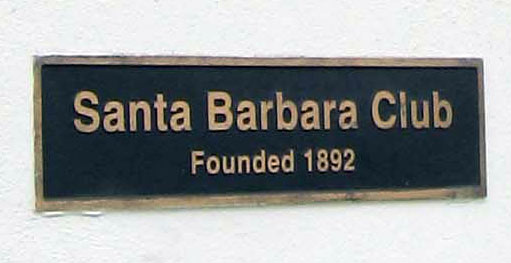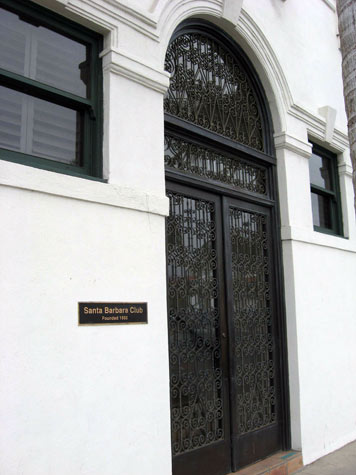Private, But Not Exclusive
Weird SB Finds Out That Social Clubs Aren't So Weird After All

In recent years, the term “gentleman’s club” has been co-opted by such establishments as the Spearmint Rhino, while the term “club” alone has come to suggest the Wildcat or Tonic, in common parlance. But a true gentleman’s club is something entirely different – not least because, in such a place, one might expect to occasionally find a gentleman.
Although a city like London, where the standard for such things was set, seems a likelier venue for a true gentleman’s club, Santa Barbara has three private clubs which fit the model – one of which has also admitted ladies for the last decade, one of which began accepting women in the 1980s, and the third of which is actually for ladies only. The oldest private club in Santa Barbara is the eponymous Santa Barbara Club, which has been a fixture in town for 116 years.
In 1892, The Arlington Jockey Club – a loose association of gentlemen with an interest in horses – originated the Santa Barbara Club, and built a clubhouse at the corner of Chapala and Figueroa streets. When the club was founded, its primary purpose was to give businessmen who had traveled from the Santa Ynez Valley – a long trip, when made by stagecoach or on horseback – somewhere to stay the night. Robert Meghreblian, current chairman of the Santa Barbara Club’s house committee, told me that the original members considered Santa Barbara’s hotels to be too rowdy.
If they could see what the word “club” is used for now, one can imagine that they might have heart attacks all round.
Of course, in these days of cars and airplanes, local members no longer need the Santa Barbara Club as a home away from home – and so the building has been remodeled over the years. The upstairs now holds offices, which members can rent as an alternative to finding other commercial space in the downtown area. I had the opportunity to look into one of these offices, and they’re both as practical and as comfortable as other office space might be. They also have the distinct advantage of being next door to a games room and upstairs from a library, dining room, and bar.

While the comfortable, and even luxurious, appointments of the Santa Barbara Club attest to a fair degree of financial security on the part of members and the club as a whole, Meghreblian informed me that income is never a consideration in the choice of new members. A common misconception about private clubs is that they’re the resort of the very wealthy only; this is not at all the case. In fact, the Santa Barbara Club uses a sort of sliding scale: young members, and those just getting their careers going, are subsidized by other members who have made a secure place for themselves. It’s a remarkably equitable and companionable arrangement.
Membership is not an easy thing to achieve, however. Meghreblian used the analogy of a blind date – one which has been arranged by a mutual friend. The prospective date has been pre-screened; he or she was chosen on the basis of something the mutual friend thinks the principals might have in common. The same is true of prospective members of the Santa Barbara Club, who must be recommended by two current members.
And with only 180 full members and some twenty part-time members, this system makes a great deal of sense. It’s hard to avoid any other member – and hence the importance of a screening process. After all, a private club is designed to be a sanctuary, and each member will have to look at every other across a dining room table for the next fifty years, perhaps. In this way, the Santa Barbara Club more resembles a long-standing group of friends than anything else; the object is to gather a sufficient number of congenial souls with common interests to keep the club running, not to divide a community on the basis of wealth.
This idea of community is one which Meghreblian stressed to me, during our interview. Most members of the Santa Barbara Club are active in arts and community organizations. The meeting rooms at the club are often used for board meetings of various non-profit organizations. The group itself functions as a microcosm of Santa Barbara as a whole club committees tend to be remarkably well-informed, as any given area of expertise will probably be represented by one member or another.
Throughout its history, the Santa Barbara Club has also allowed the spouses of members to use club facilities. For the last decade, the club has been admitting female members, and husbands and wives of members are now both given honorary status in the club. Some of these spouses use rooms for book club meetings, while others just enjoy the quiet and the excellent food.
Although the club’s inclusion of female members has been a fairly recent development, women’s interest in this sort of environment is not new. The Little Town Club, a comparable establishment for ladies only, is also downtown, only a few blocks from the Santa Barbara Club. While representatives of the Little Town Club declined to comment on how long it has been in existence, it quite possibly was founded to provide a place for women who appreciated the same type of environment and amenities enjoyed by Santa Barbara Club members.
Of course, the fact that the Santa Barbara Club has begun to admit female members makes the existence of a women-only club somewhat less necessary. (Furthermore, the University Club falls along somewhat different lines, as it accepts specifically people who have graduated from a university.) But the purpose of each is to provide a place for community members who may not want to experience the more typical club environment. That’s what a gentleman’s club has traditionally been; and no matter what the Spearmint Rhino says, that’s what a real gentleman’s club, with or without ladies, continues to be.



